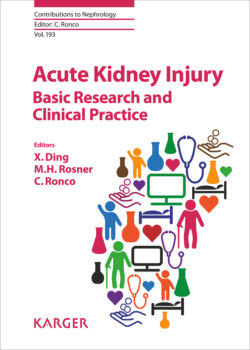Читать книгу Acute Kidney Injury - Basic Research and Clinical Practice - Группа авторов - Страница 24
На сайте Литреса книга снята с продажи.
Introduction
ОглавлениеAcute kidney injury (AKI) is defined by a rapid deterioration in kidney function resulting in reduced clearance of excess fluid, electrolytes and toxins. It is remarkably prevalent among hospitalized patients and is associated with adverse outcomes such as prolonged length of stay and increased mortality [1]. Previous studies reported AKI incidence ranges between 5 and 7% of hospitalized patients [2–4], and resulting in a 1.7–6.9-fold increased risk of hospital mortality [5]. Recent data suggest that AKI has consequences not only during the acute phase, but also in long-term phases, resulting in progressive chronic kidney disease [6] and end-stage kidney disease requiring dialysis or kidney transplantation [5, 7, 8].
Recognizing this, the International Society of Nephrology (ISN) set a goal of eliminating preventable or treatable death from AKI by 2025, the “0 by 25” initiative [9]. However, the implementation of this scheme requires full consideration of the quality measure throughout the AKI management, and risk assessment is the first stage.
